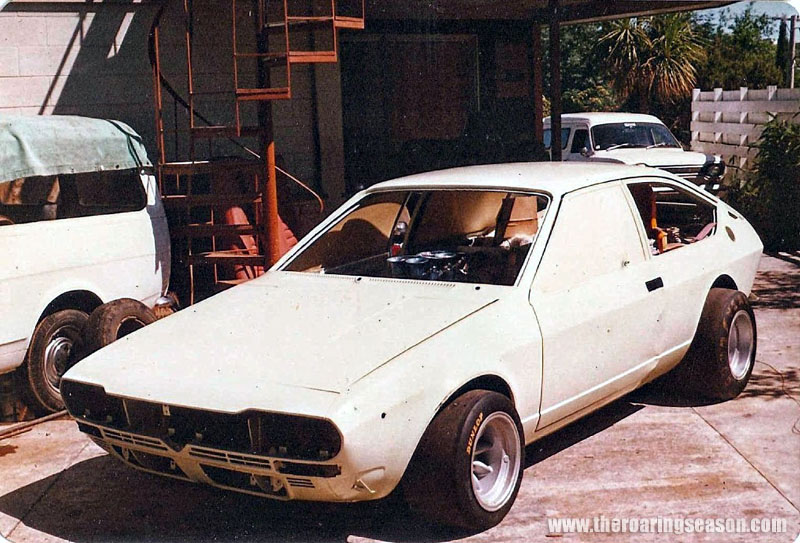-
Administrator


The Ian Algie Sports Sedan project began around 1978, when Ian and Barry took a trip to Italy, where they purchased a brand new Alfa Romeo Alfetta GT bodyshell. When Ian began planning the car, there wasn’t actually a class in which to race it. The New Zealand Saloon Car Championship was now defunct, and the Sports Sedan Association had yet to be formed. He simply pushed forward with the project working on the basis that, when finished, there would be somewhere in which it would be accepted.
In addition to the body was also purchased various other Alfetta components, including standard Alfa Romeo suspension pieces, De-Dion, steering parts, and the famed Alfetta trans-axle which incorporated gearbox, clutch, differential, and rear brakes. Ian decided on an Alfetta after studying a motoring annual of new cars from around the world, in which were provided various details including overall weight, front-rear weight bias, wheelbase, width, length, and drag-coefficient. The Alfetta was the model which appeared to offer the best all-round package as the basis for a heavily modified racing sedan.
Surprisingly, given the ambitious nature of the Alfetta, Algie had little prior racing background, other than Go-Karting. This would be the first car he built for himself. At the time he purchased the Alfetta, he and Barry were working in Canada, repairing trucks. Ian himself has a background in vehicle bodywork.
While in Italy, the brothers visited Autodelta, Alfa Romeos competition department, and attempted to purchase a set of fibreglass Alfetta wheel flares, as used on the companies Group 2 rally cars. However, this process proved too difficult. Instead, they’d make their own molds and cast their own flares when they got back to New Zealand.
They also went to England where other components were purchased, including magnesium Minilite wheels, measuring 13 inches in diameter, 10 inches wide for the front, and 13 inches for the rear. Then they purchased brake components from AP Racing Division.
Getting the Alfetta body and parts back to New Zealand was an adventure in itself. Indeed, it was first shipped to Canada. While there, Ian spent time ageing the body, adding primer patches to make it appear used, in a bid to pay less import tax when it was entered into New Zealand. And, when it did eventually arrive, it had to be registered, as per regulations of the time, and given a licence plate number, even though there was never any plan to use it on the road.
Ian originally planned to power the Alfetta with a turbocharged Porsche racing engine. Even in endurance spec, the twin turbocharged air-cooled flat-6 produced around 560 horsepower, but for shorter events, could easily reach 750 – 800 horsepower. In addition it was relatively lightweight, which fit perfectly with his plans for the car. However, despite an intensive search, none could be found. Indeed, even if he were to achieve this, the cost to import it into New Zealand would be prohibitive. Instead, Barry discovered the Halliday brothers Don and Rob had for sale a fuel-injected 5 litre Chaparral built small block Chevrolet V8 which had previously powered Ken Smith’s Lola T332 Formula 5000. This was purchased instead.
Ian’s focus for the Alfetta, from the outset, was to get weight towards the rear. Essentially, he was building a sedan version of a mid-engined single seater or Can-Am sports car. To that end, he decided to fit the Chevrolet V8 behind the firewall, where the front seats would normally be. His thinking was two-fold. He wanted all the weight between the front and rear wheels. But he also hated the thought of cutting up his brand new bodyshell. Most modified racing sedans, be they from the OSCA series, the extinct New Zealand Saloon Car Championship, or the upcoming Sports Sedan category, allowed for some movement of the engine for better weight distribution, but this was typically limited to around 12 inches. For most cars, this placed the rear part of the engine inside the passenger compartment, while the front was still in the engine bay. To achieve this required cutting a large hole in the firewall, and then building a shroud around the rear of the engine. However, Algie positioned his entire engine behind the firewall, inside the cabin. That meant he would need to drive the car positioned where the back seat would normally be.
Other than the engine, most other heavy components were mounted between the front and rear wheels, including the fuel tank, which sat alongside the driver. Ian achieved his desired 40/60 front/rear weight bias.
Safety equipment was minimal, with a simple aluminium rollcage fixed at four points from the B-Pillar back. Again, this was in a quest to keep weight down.
 Posting Permissions
Posting Permissions
- You may not post new threads
- You may not post replies
- You may not post attachments
- You may not edit your posts
-
Forum Rules






 Reply With Quote
Reply With Quote